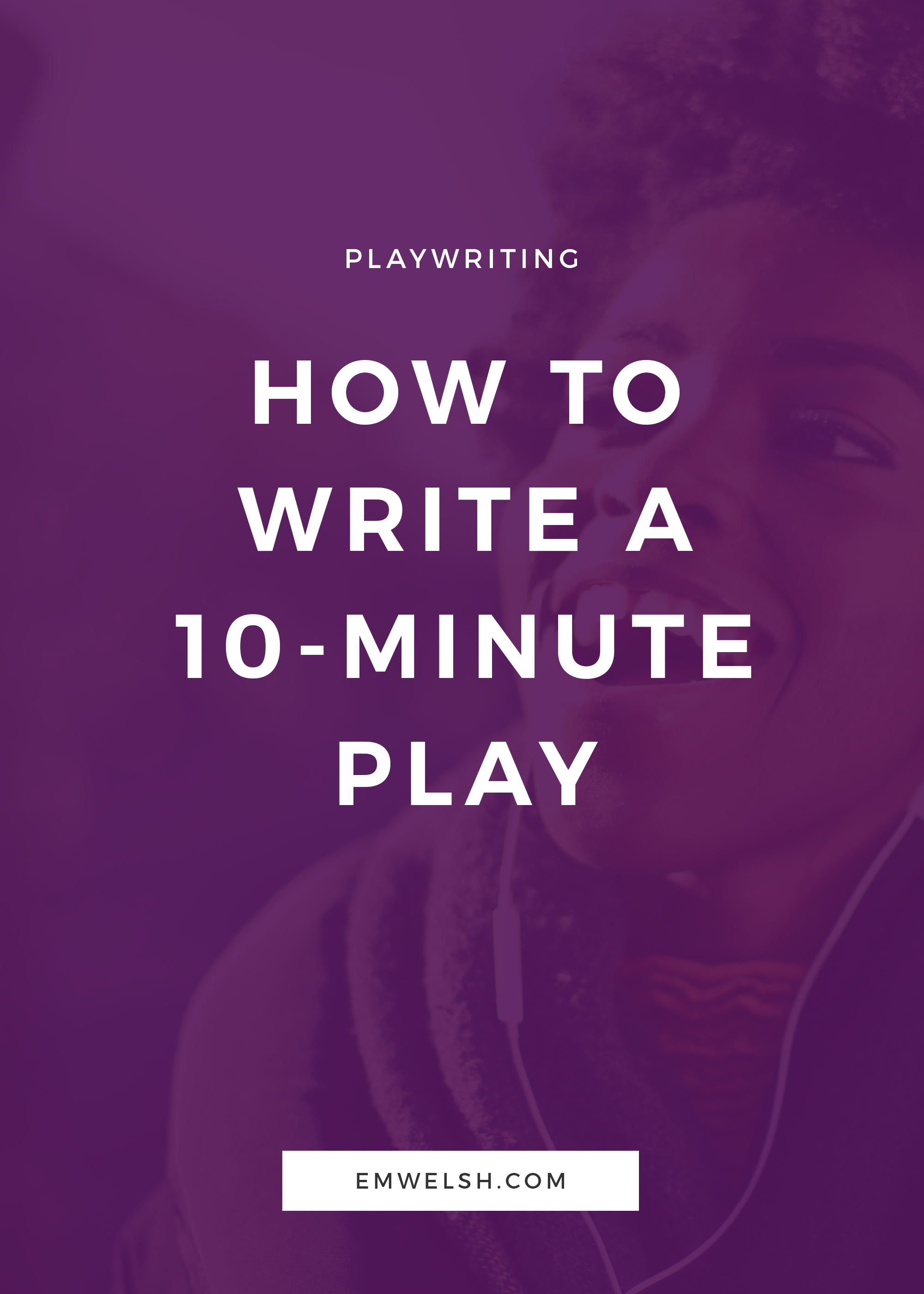How to Write a 10-Minute Play
/If you're new to playwriting and want to practice playwriting, there is no better way than to learn how to write a 10-minute play. Not only is the piece short and sweet, but it makes it easy to practice over and over without wasting time. You can feel free to make errors, write dumb lines of dialogue, and tell a story that makes no sense all at the cost of 10 pages or so. (If that seems like a lot to you, remember that play pages are much shorter than fiction pages.)
For those who are new to theater, a 10-minute play is a short story that lasts no more than 10 minutes long. It usually is a vignette in a series of plays at a festival or competition and offers a great way to practice writing for theater. Below, you'll learn how to write a 10-minute play and tips for starting out.
Requirements of a 10-Minute Play
Stick to 10-minutes
This is a fairly simple rule to understand, but when you're writing a 10-minute play, you actually must stick to the 10 minutes allotted to you. You wouldn't ignore a word count rule for a short story, so neither should you ignore a time limit for a play.
As a writer, the timing is somewhat beyond your control if you are not also directing your piece, as the speed at which lines are said can change the pace of your story. However, to make sure you're on target when writing, be sure to read each draft out loud with a timer on hand.
(I mean it. Your story really has to be 10-minutes long if you want to have a chance anywhere!)
Create a story with an arc
It might seem obvious that you should write a story with an arc of some sort, but often what can happen in 10-minute plays is that you'll end up writing a sketch instead of play. While the difference is minute, a sketch tends to be working towards a punchline, even in dramatic instances, whereas a play has an arc to either the story or character.
Often a play can have something similar to a punchline called the climax, but that isn't what the story is completely working towards. Instead, the climax just marks the apex of the story, not what the story has been working towards. The action following the climax is equally as important to understanding the story, whereas in a sketch, the punchline is the end of the narrative.
Additionally, in sketches, there is no character development or purpose to the story besides the punchline. For a play, even characters do not change, there is a realization or arc to the narrative beyond this final point.
How to Write a 10-Minute Play
When writing a 10-minute play, any method can be used to brainstorm the standard parts of any story, such as the character, world, and so forth. For best results, focus your brainstorm for a 10-minute play on the same things you would for a short story.
Whether you do these things before you begin writing your play or after, is up to your short story writing approach. However you do it though, you'll want to stick to the following how-to:
1. Ask a question
According to Sam Graber, every 10-minute play should ask a question. This truly goes for any play in my opinion, but it is something to keep in mind when writing a 10-minute play as it helps you avoid writing a sketch.
Your play can ask any sort of question. It can be a simple one, such as "What would happen if someone found their true love two months before their death?" to something more ambiguous like "Is loyalty good?"
Whatever you ask, make this the thesis of your play. It will give your play purpose, keep your story focused, and reveal many other important things like your story's theme and motifs.
2. Develop your character, conflict, and setting.
This isn't new information. For any story you write, you'll have to develop these things. After you've asked the main question of your 10-minute play, you'll want to flesh out character, setting, and the conflict that derives from your question.
For theater, character is extremely important as the entire is communicated by people. There isn't a camera for editing, language for someone to read and process, but raw human connection between the actors and the audience.
Because of this, you'll really want to focus on character first and foremost. Develop at least one complex character to intrigue your audience, then if you get stuck, movie on to the conflict that is rooted in your story. After developing that, you can then focus on setting, but know that given the constraints of theater, setting is often attributed to the imagination of the actors and audience, so fleshing out minute details for a 10-minute play may only be helpful for your own brainstorming.
3. Skip exposition
As we've emphasized, you only have 10 minutes—and not a second more—in your 10-minute play. Given this time constraint, you'll need to skip exposition of any kind to get to the center of your story. While you may be tempted to slip it in with a few lines of dialogue, it really isn't worth the time you'll lose. When you could be pushing the narrative forward, you'll be wasting precious seconds talking about something that the audience likely doesn't need to know.
Keep in mind that in short fiction and even short films, exposition often makes up a few sentences or paragraphs, or the opening shot. But in short fiction, the reader dictates the pace of the story, so there is room for creative exposition and a slower narrative. For short films, you should stray away from exposition, but occasionally films may introduce them because they aren't in time crunch.
But in a 10-minute play, you are bound to that time limit. While many short films would be better without exposition, you really cannot afford in a 10-minute play to waste any time on exposition. If you feel that exposition is necessary in any way, then you may have a full-length play instead of a 10-minute one. In which case, this guide is no longer of use to your narrative.
4. Introduce the conflict quickly
Just because you skip the exposition, doesn't mean you should take your time introducing the conflict. Introduce the conflict as soon as possible so the audience knows why they're following your story right away.
You don't have to introduce it in the first line of dialogue, but ideally in the first minute of the page, the second minute at the latest. Even if you have a more subtle conflict that audience members can't pick up on right away, it's still essential that you introduce the conflict as soon as possible. It's a part of answering the question you asked before you began writing, which brings me to...
5. Use the play to answer the question you asked
Your entire play should work to answer the question you asked before you even started your script. This could mean a resounding climax for some stories, or it could mean something more subtle and haunting. Whatever it is, every page, every line, every movement of your play should seek to somehow answer the question you asked at the beginning.
When editing future drafts, look at each part and ask yourself how the piece answers the question. If it doesn't answer the question, rewrite it so that it does or scrap it all together. With only 10 minutes, every single part of your story must answer the question you asked when you began this play.
Tips for Writing a 10-Minute Play
Get creative and take risks
One of the most exciting parts of writing a 10-minute play is the experimentation you can easily incorporate into your story. It can be in a draft, or in the piece itself, but given that you have such a short time, you can really get creative and take risks without wasting tons of time.
So, if it's your first time writing a 10-minute play, don't stress about getting things right, but instead, let your imagination take over and do things you usually wouldn't think to do. The worst that can happen is you'll have to rewrite the piece, and that will only consist of 10-15 pages.
Cut out extraneous details
It's called a 10-minute play. Unlike a short story, there is an actual time limit to this piece, so cut out anything that isn't relevant to your story. This could be a side character, a scene, or a line of dialogue. Once you've written your script, look at it with a critical eye and treat every detail of your story like a choice. Ask yourself if it answers your main question you posited at the beginning of this post, and if it doesn't, cut it out.
Use action to add depth
Avoid telling the entire story with dialogue alone. You have living, breathing people on stage who can use their bodies, their movement, their expressions to tell even more. Make your story more efficient and jam-pack it with more information by adding in action that signals deeper meanings.
Make sure your idea is meant for a 10-minute play
This is a big problem you'll find in short stories of all types, be it film, fiction, or playwriting. You think you have a great idea for a short story, and then suddenly realize you've tried to cram a three-act story into a short story.
It doesn't work.
If you are running into continuous issues with your 10-minute play, it may be worth evaluating whether your story is for a short play or a full-length play. If you aren't sure, take a look at what makes a short story (be it fiction, film, or so forth) different.








